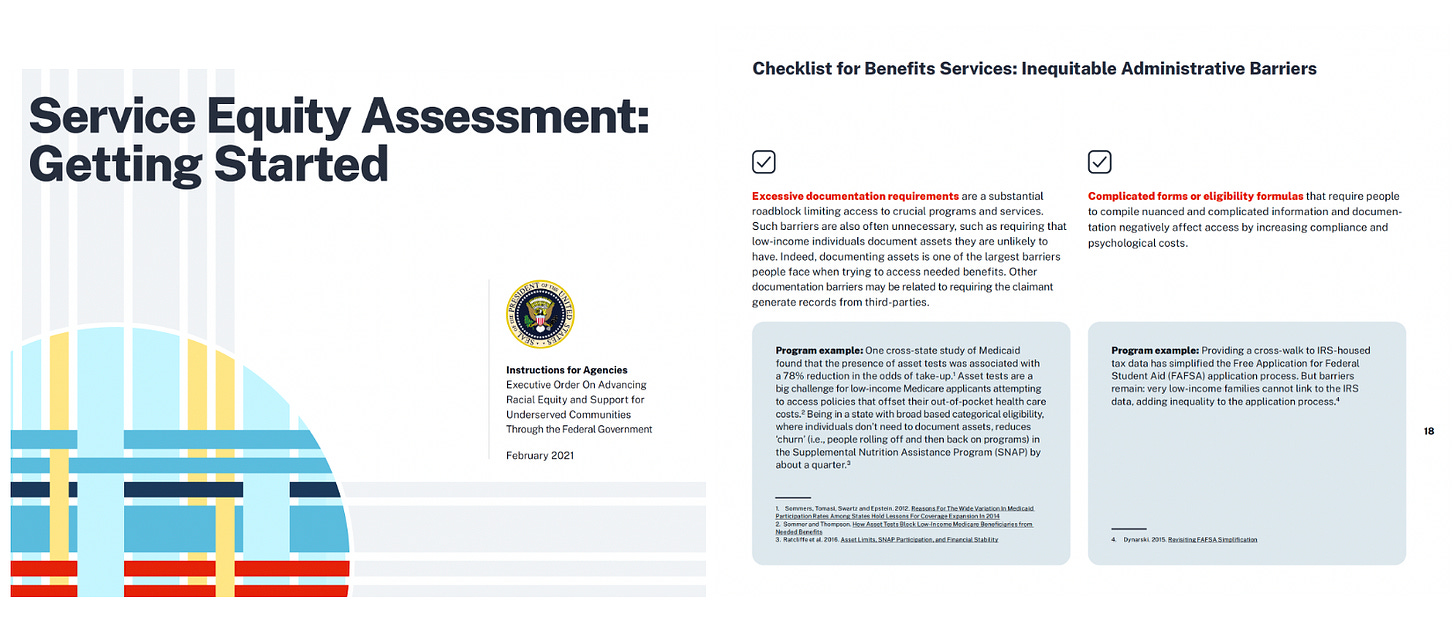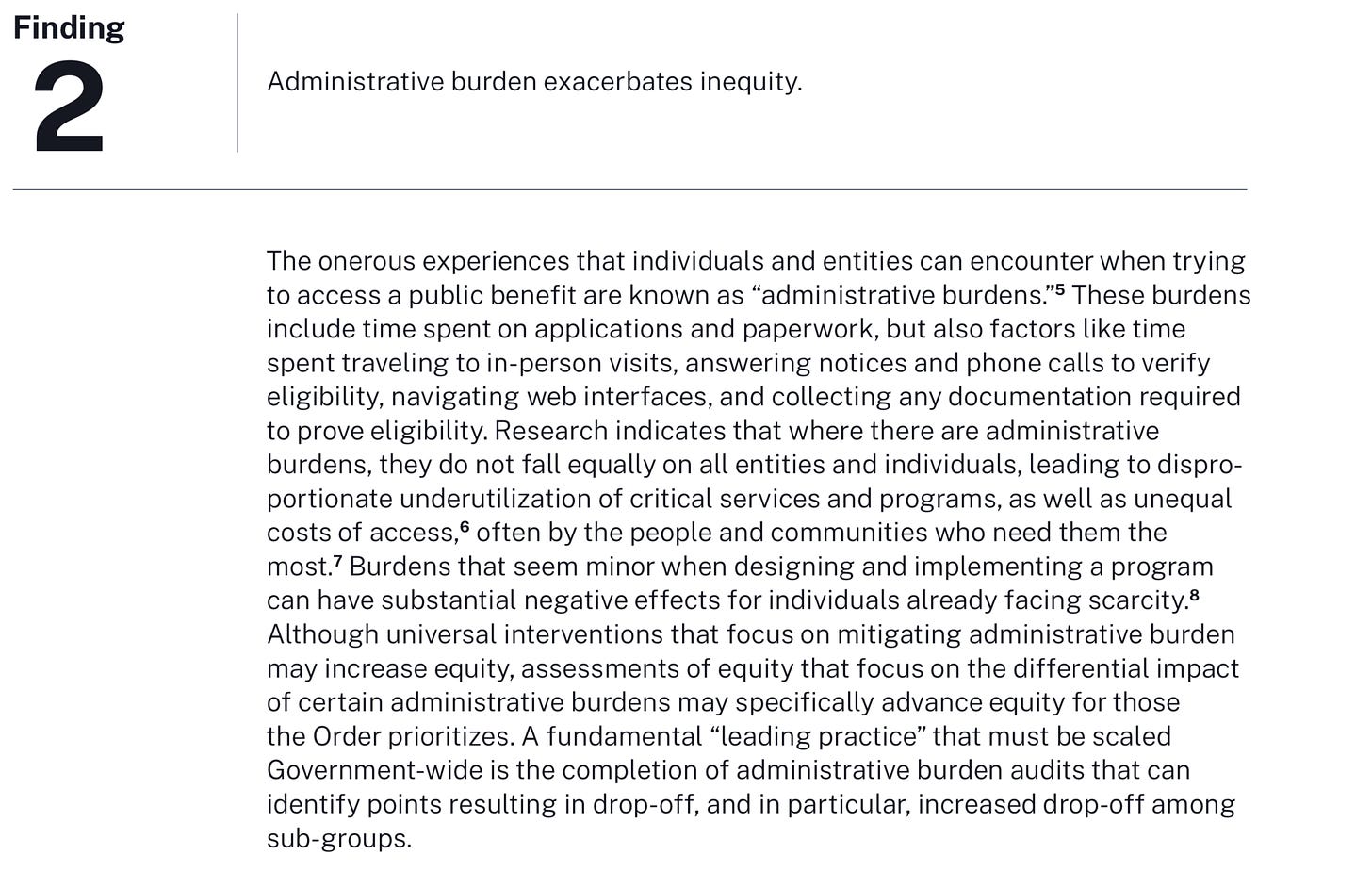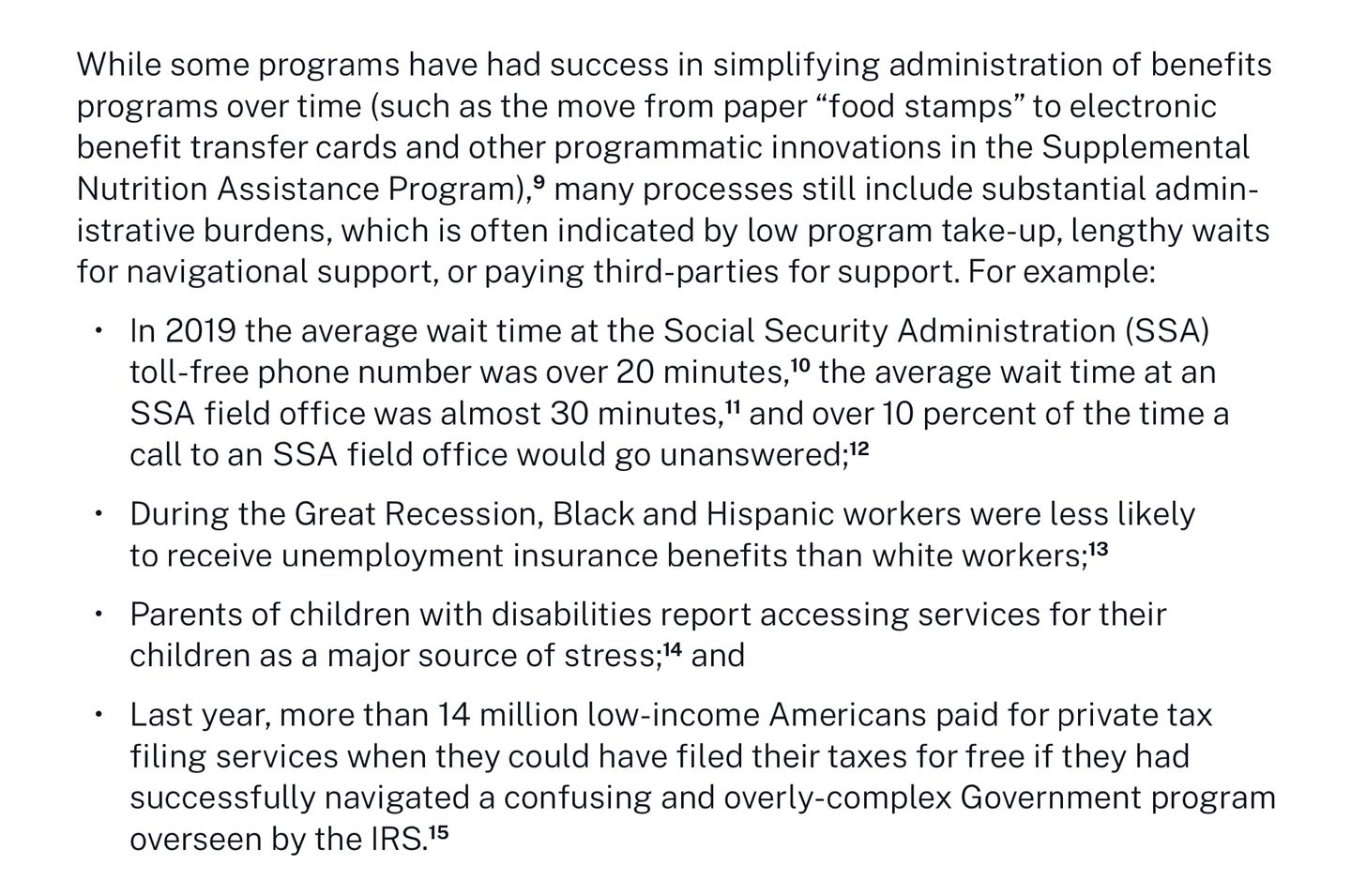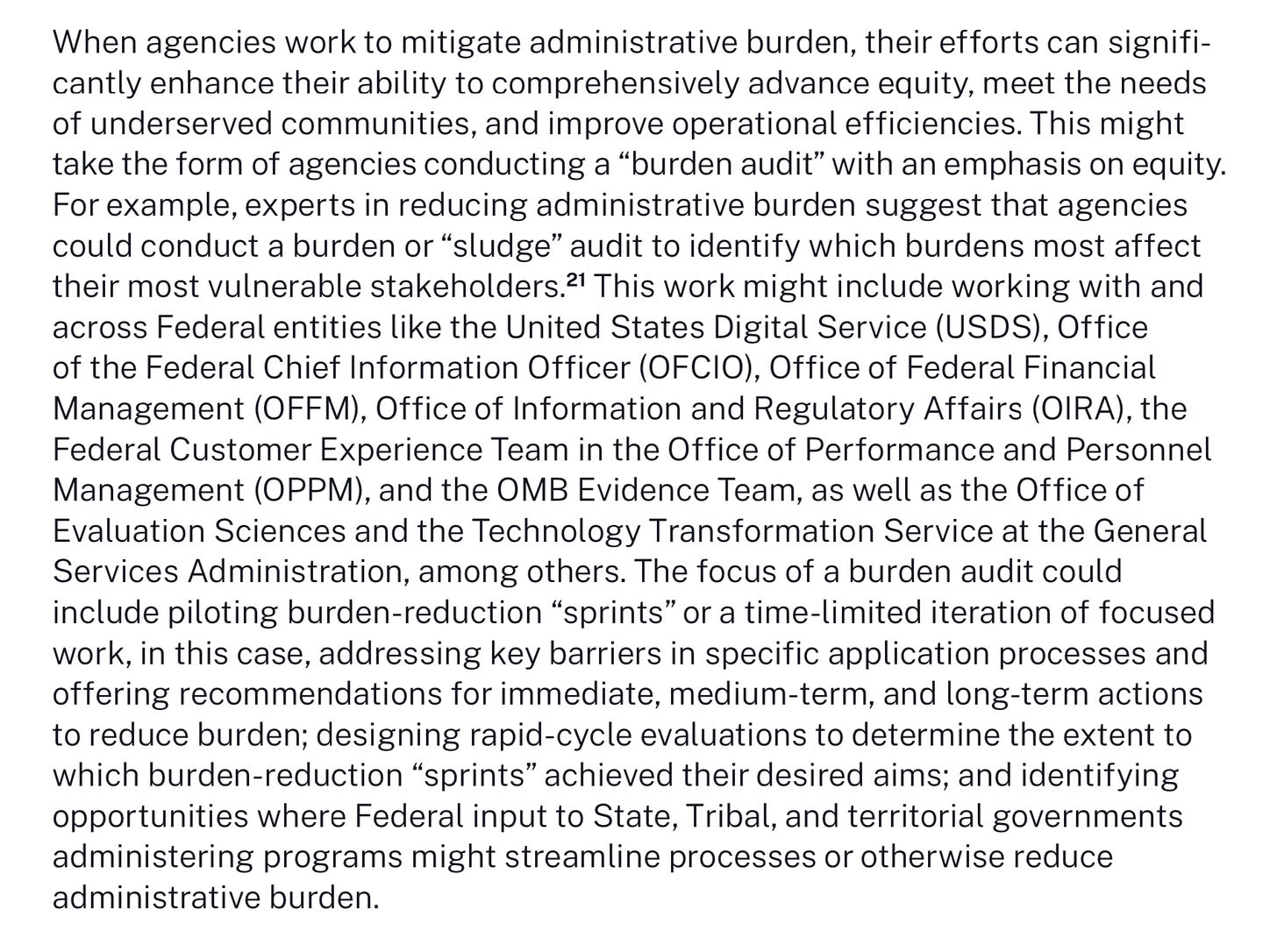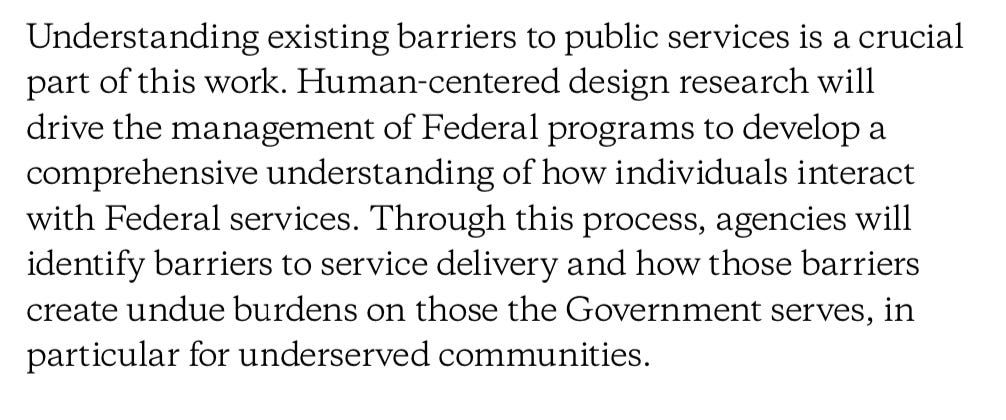The Biden Administration Is Taking Administrative Burdens Seriously
The emergence of a governing philosophy
It’s hard to get people to pay attention to government administration, unless something has gone wrong. But Biden was elected on the promise of a return to normalcy and competence, and policy implementation is also de facto policymaking. Here, and in a series of future posts, I’m going to talk about one very specific way Bidenism is shaping policy outcomes by improving the quality of government: reducing administrative burdens.
This sort of stuff might seem like the ultimate inside baseball. And in some ways it is. There is no culture war red meat. It’s sort of boring. It might take a while to see outcomes. But it’s also an insight into how the machinery of government works, albeit slowly, and the ways in which governing philosophies are embedded into that machinery.
It is a good thing for the quality of government that progressives are paying more attention to administrative burden. In my book with Pam Herd on the topic, we bemoaned the fact that conservatives seemed to understand the power of burdens, but have used that understanding to make government dysfunctional. Progressives, on the other hand, were just not paying attention. Instead, they focus on building new programs rather than making sure the ones we already have work. And they fail to think about burdens in policy design, proposing narrowly targeted programs that prove difficult to implement.
Governmentwide vs. policy-specific approaches
We can think about Biden’s efforts to reduce administrative burdens in two ways. One is policy specific. In policy domains like health and welfare, the Biden administration has made it easier for people to access services. In many cases, this involves fixing messes made by the Trump administration. In each particular case, the changes made might be seen only in the context of that policy, e.g., the Biden administration is fixing ACA access, or student loan forgiveness.
The second approach is to articulate a broader governmentwide philosophy and build a set of administrative processes to achieve that philosophy. This, for me, is more interesting, and more likely to have a lasting impact. Think, for example, of Ronald Reagan’s adoption of cost-benefit analysis into the federal government. For 40 years now, it has shaped the ways in which the federal government (and many states that followed) structured their regulatory relationship with business.
While cost-benefit analysis guarantees government attention to the regulatory frictions experienced by businesses, there is nothing equivalent for members of the public, beyond the relatively toothless Paperwork Reduction Act. Until now.
The Biden administration is taking administrative burdens seriously and trying to find ways to monitor and reduce them in government.
The two approaches to budens – policy-specific and governmentwide – are related. To the extent Biden talked about burdens as a candidate it was in the context of specific policy domains, like immigration or healthcare, e.g.:

Policy wonks in these policy-specific domains do not necessarily think of themselves as engaged in some broader enterprise of fixing burdens. Thus, articulating a broader philosophy beyond policy domains is necessary and important for a few reasons.
Salience: Policy wonks reducing burdens come to understand that they are not just fixing SNAP or Medicaid or whatever policy domain they are associated with, but are part of a broader effort to improve the quality of government, and make people’s experience of government better. Such signals go to agency officials within government, but also external stakeholders.
Legibility: Once governments start paying attention to administrative burdens, they are more apt to measure them, to look for evidence about their impacts, to understand how they hurt some groups more than others. This provides the bureaucratic justification to do more.
Knowledge dissemination: Knowledge accumulation develops more quickly once paradigmatic ideas are named and articulated. For example, the diffusion of cost-benefit analyses as a domain of knowledge, with research, textbooks and graduate level courses, is in no small part because the government defined it to be a relevant competence. Studying burdens across domains makes it easier to generate a toolbox of solutions.
Tracking the outlines of a burden reduction policy
There is no single place where you can find a Biden speech where he focused on his administration’s approach to administrative burdens. But there are a couple of important documents that provide an insight into what is happening if you look closely enough.
The Equity Executive Order
First off is Biden’s equity executive order, signed on his inaugural day. It is easy for outsiders to dismiss executive orders but they have the power of law. If you talk to people working in the Executive Office of the President, they take them seriously. Equity is one of Biden’s “four pillars” that he campaigned on (the others are COVID, climate and the economy). Being able to tie any initiative to those four pillars means that it gets high level attention in the White House.
Under the order, the Office of Management and Budget is told to look for practices to improve equity, and for federal agencies to conduct equity assessments (see sections 4 and 5 of the order, below). Crucially, the order identifies “barriers that underserved communities and individuals may face to enrollment and in access to benefits and services in Federal programs.”
Th executive order leaves a lot of discretion to OMB officials. This sort of work is a key part of OMB’s job: converting broad presidential goals into specific guidance so agencies don’t have to figure it out themselves, and ensuring some consistency in approach so each agency doesn’t come back with something different. OMB officials who do this are different from the policy wonks who might obsess over burdens in a single program like SNAP. They take a governmentwide view, and some of them were already thinking about the issues of burden from other perspectives, such as customer service, and human-centered design.
OMB Guidance to Agencies
By February 2021, OMB has provided internal guidance to agencies about how to do equity assessments. This isn’t publicly shared (though you can find a copy of it here). Thus, within a month of Biden’s arrival, agencies are being told to pay attention to burdens as a means of satisfying the equity executive order, and given a checklist about the source of burdens in public programs. (Full disclosure, with colleagues Pam Herd and Sebastian Jilke, I gave suggestions to OMB as they prepared this document).
OMB Report to the President
In May, OMB formally solicited comments from the public about ways to advance equity, including “Approaches and methods for assessing and remedying barriers, burden, and inequities in public service delivery and access.” As much as anything, such requests for comments tell stakeholders that this topic is important, pushing them to start thinking about it.
By July, OMB delivers its report about tools to assess and improve equity. One of the five main findings of the report is that “administrative burden exacerbates inequality.” This finding connects the burdens to Biden’s executive order, and gives OMB license to do something about it. Unlike the February report, this is public, and thus repsresents an explicit statement of how the goovenment is implementing Biden’s policies.
The report draws on research from economics, public policy and public administration. It describes how burdens led to the types of barriers that lower take-up to crucial services that Biden’s EO referenced.
The report identifies the need for burden or sludge audits (hat tip to Cass Sunstein): routinely assessing programs to detect burdens. It also activates parts of the federal government that should be playing a role in reducing burden by naming specific agencies. This is how agencies are directed to prioritize administrative goals, and how such goals ultimately become institutionalized. Agency leaders are effectively being told: the President cares about this, so put in on your radar.
Finally, OMB provides a deep dive analysis of administrative factors that create burdens, and potential solutions (sample below).
The President’s Management Agenda
On November 18, Biden unveiled The President’s Management Agenda. The PMA maps out the key management goals of an administration. Biden’s version maps out three big strategies. The first is to strengthen and empower the federal workforce. This is not surprising after the politicization and decline in morale of the Trump era, although many problems in personnel issues (like hiring people on a timely basis) predate Trump. The third strategy focuses on fixing government systems in ways that, in theory, improve the implementation of Biden’s Build Back Better policy, e.g. fixing federal acquisition and financial management practices.
The second PMA strategy is the one that relates to burdens: “Delivering excellent, equitable, and secure Federal services and customer experience.” The strategy calls for service providers who directly interact with the public to improve public experiences by “reducing customer burden, addressing inequities, and streamlining processes” In addition, the plan calls for organizing service delivery around the perspective of the user, rather than agencies.
Previous federal governments have emphasized customer service. It was, for example, a staple of the Clinton-Gore Reinventing Government initiative. Unlike the past, the Biden-era emphasis on burdens directs attention to equity and access as an aspect of customer service. It is not enough that the person who gets a benefit like the Child Tax Credit reports good customer experience - you also need to think of the eligible individual who does not get the benefit, and reach out to them.
As the above language from the PMA signifies, a cluster of approaches is being combined here: customer service, human-centered design that maps user journeys, and administrative burdens that focuses on access and equity.
The start of something big?
It is too early to say if this is a moment equivalent to Reagan’s prioritization of cost-benefit analysis. It’s fair to ask what meaningful effects we will see moving forward. In future posts, I will talk about some specific examples of tangible policy-specific reductions in burdens that will help people. But I think it’s important to understand the governing philosophy first, and in future posts I will also talk about why I think this philosophy will endure.
I’ve been studying the topic of administrative burdens for over a decade now. It is fair to say that Biden is thinking about the ways in which administrative burdens limit access to valued public services more than any prior Presidency of the modern era. Indeed, what the Biden administration is doing represents the most coherent governmentwide effort to identify and reduce burdens for regular members of the public I have seen any government pursue. It is offering a framework to push bureaucrats to think about ways in which they impose costs on members of the public and offers some tools to fix this problem.
This is new, and positive, and we should applaud it if we want to see it continued.
If you liked this post, please consider subscribing to “Can We Still Govern?” if you have not done so already.





